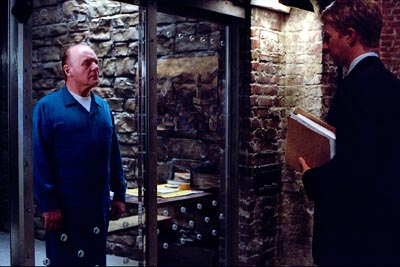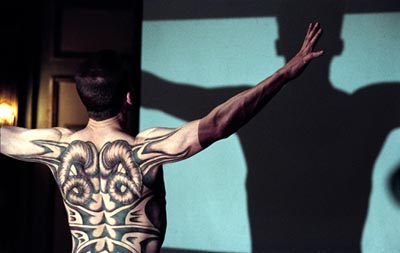

The main reason that Red Dragon even exists is to capitalize on the momentum of Hannibal, the oh-so mediocre sequel to The Silence of the Lambs. In fact, there was already a film version of Thomas Harris' novel entitled Manhunter, a highly underappreciated 1986 film that starred Brian Cox as Hannibal Lecter. Still, Anthony Hopkins (Bad Company, Hearts in Atlantis) will forever remain seared onto the minds of millions as Hannibal the Cannibal, the sadistic, insane genius that rarely blinks. Red Dragon falls somewhere in between Hannibal and The Silence of the Lambs, but probably closer to the latter. There is no real effort to do anything original or different; this movie is more of a good copying of Silence. Because it is copying such a good movie so well, Red Dragon comes across as halfway decent.
The events this time take place before The Silence of the Lambs. In a quick introduction, the audience finally gets to see how Special Agent Will Graham (Ed Norton, Death to Smoochy, The Score) caught Lecter, almost at the cost of his life. Flash forward to a couple years later, when Graham's old boss Jack Crawford (Harvey Keitel, Little Nicky, U-571) enlists his help in finding a serial killer known as the Tooth Fairy. He wants Graham to go to Lecter for help, since Lecter still enjoys taunting Graham. The Tooth Fairy is Francis Dolarhyde (Ralph Feinnes, The End of the Affair, Onegin), a socially maladjusted man who is trying to become a living dragon, patterned after the watercolor painting by William Blake. Reba McClane (Emily Watson, Gosford Park, The Luhzin Defence) is a blind co-worker of Dolarhyde's, who takes an interest in him.
The movie itself probably attracted this amazing cast, most of whom run around not doing much of anything. It's a surprisingly standard story, with director Brett Ratner (Rush Hour 2, The Family Man) splitting time between Graham pursing clues and Dolarhyde acting strange. There is a decent amount of suspense, as well as a decent amount of gore, but nowhere as over-the-top as in Hannibal. It just seems so familiar. Everybody knows that Lecter is going to do his best to try to undermine Graham by continual taunting, and that regardless, Graham will eventually figure out that Dolarhyde is the killer. Ted Tally's (All the Pretty Horses, Before and After) screenplay is not one where the identity of the killer is unknown. It is more two stories that eventually converge. In this case it works because one can see how Dolarhyde is thinking, and what his motivations are. By the way, Tally also wrote the screenplay for The Silence of the Lambs.
However, it all boils down to Hopkins. In all three movies his character is the center, so somehow all the events will revolve around him. Maybe since this is the third time, the effect is wearing off, but Lecter does not seem as menacing. Keitel, Mary-Louise Parker (The Five Senses, Let the Devil Wear Black), and Philip Seymour Hoffman (Almost Famous, State and Main) are nearly wasted in minor roles. Hopkins towers over everybody else, and Norton does a valiant but futile job of standing up to him. Feinnes goes a little over the edge, turning Dolarhyde into something more of a caricature then a menace. The real menace here is behind bars, and stays there for the duration of the movie.